
Crete October 2016 (continued)
Thursday 13th October South to Agya Galini via Arkadhi Monastery 73km
The mountains looked wonderful on this beautiful morning.
After a pleasant breakfast beside the tiny courtyard pool, we packed up and left at 9.30. It had been a lovely stay.
We drove past the fortress before going through the town, passing the market which is held today.
On the eastern side of the town, we came to the enormously long sandy beach with its lines of coloured umbrellas.
We continued east until we took a road going south, following the sat nav. This took us on a rural route through remote hills with pretty villages until we reached Arkadhi Monastery. This place is of great significance to Cretans as it symbolises their struggle for independence. It is much visited – two coaches unloaded while we were there. It had an evocative attraction, a simple church standing in a walled enclave. In 1866, an explosion took place, killing dozens of people – both Greeks and Turks, while under siege from the Turks. It looked and felt like the Alamo.

Rethymno’s sandy beach
We'd had tea/coffee sitting on the wall outside, before wandering around enjoying the scenic and significant site.
We continued south through the wild mountain scenery of the Amari valley, with the very occasional incongruous field of vines, and nearer the south coast, olive trees. We had difficulty in finding shade to eat lunch, stopping beside an old olive tree, with a small horizontal bough just large enough for Adrian to sit on, but with great views.
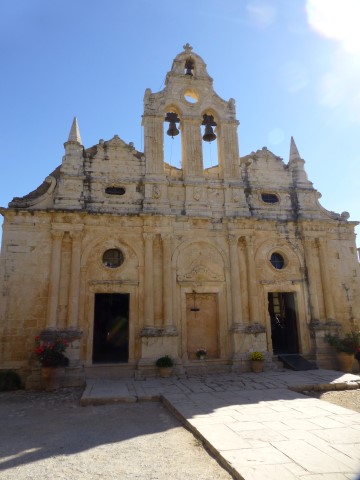
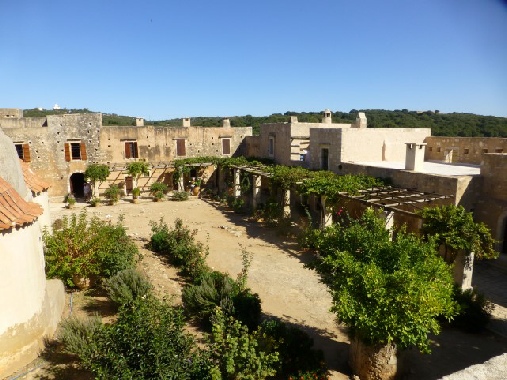
Arkahdi Monastery
We carried on south to Agya Galini, our place for the next two nights. This one-time fishing village of white houses is now used by tourist companies, and is apparently very busy in summer.
We passed our hotel, the Hotel Fevro, as we drove on down to the harbour. It was attractively bedecked with bougainvillea, but was a way back from the sea.
We had a look around the harbour area, with its plethora of fish restaurants. There was no beach here - that was a good 10 minute walk away. We drove back to the hotel and were welcomed by a lady who spoke no English, only German. She telephoned her daughter, and then offered us a room on the second floor – or on the third floor. In the afternoon heat, we didn't relish the long walk up to the third floor, so settled on the 2nd.


Lunch stop in the Amari Valley
After our last two hotels, which had excellent facilities, this one was a let down. A small but clean room, but with none of the extras – no air conditioning, no fridge, no pool, and just a tiny balcony – overlooking the next hotel's swimming pool! There was a distant glimpse of the sea. Also, there is no parking – just on-street parking. Adrian was particularly disappointed – especially when he looked up and found that we had paid more on booking.com than the going rate now, which is not usually the case. We went down to ask the manager about the air conditioning, but in German (he looked like George V) he said 'Kein problem' on 2nd floor, only top floor gets hot!.
Later we walked down to the harbour and enjoyed a wonderful fish platter for two at the Mezetzidiko Restaurant with a carafe of white wine. We walked back up the narrow street and then the many steps to our room at 10.30.
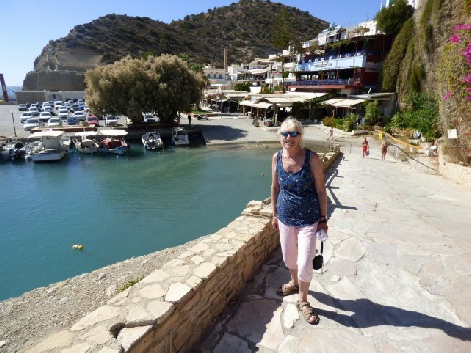

Agya Galini Harbour and the view from our hotel (note next door’s unused pool!)


Wonderful fish platter at Agya Galini
Friday 14th October 'Piles of old rocks' and a hippy beach 125km
We had two days booked at this hotel, so today was the day to go off exploring.
It was cool until the sun got to us, then a beautifully warm day.
We enjoyed a good breakfast sitting on the terrace, with the unfortunate sight of a half finished building beside us.
We left at 10 o'clock, stopping to buy drinking water and then to get fuel. We drove into the hills, passing through timeless white villages with delightful views down to the sea. We stopped in this peaceful mountain setting to have coffee under the olive trees. The only sound was the bleating and the bells of the goats.
At the village of Kamares, two goats actually blocked the road, tethered to a man who was sitting at the side. We made a diversion through the village here, glad that we weren't in the van as it was all so narrow!
At Vorizia we were amused at a small cabbage plantation beside the plantings of fir trees.
At Zaros we had to negotiate past two huge lorries and later a tanker, on these tiny roads.
We headed for nearby Limni Lake at Votomas, an artificial pond full of trout. Its dark green colour looked very attractive beneath the sheer vertical white cliffs. There were rustic wooden seats beside it – we should have stopped here to have our lunch, as picnic spots in the shade are hard to find.


A patch of cabbages in the dry hills!!
Beehives - a more common sight
We continued to Agya Varvara, where there was nothing of note. From here we took the busy road south, where there were no pull-offs – why hadn't we taken the smaller road which Adrian had suggested?
We drove through the town of Ayii Dkeki, stopping soon afterwards at the ancient site of Gortyz. There was a large parking area here, but with very little shade, and no seats. We managed to stop beside an old bit of wall, and sit there to have our lunch. This significant vast site was hard to orientate. We crossed the road, but it really was just 'a pile of old rocks', and we couldn't make anything out, despite having a map in our guide book. There was a roped off olive tree, supposedly 1,600 years old, although others nearby were more impressive.

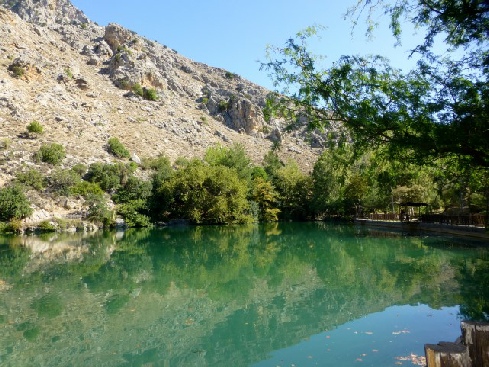
Limni Lake at Votomas
Back on our side of the road, we came to the entrance and paid our €3 (€4 normal rate). There was no map – we were lent a useless laminated sheet in Greek. The thing to see was the ruins of St Titus church. It seems to be the oldest Christian church, but it was all roped off! Adrian wandered down to the Odeon where there were ancient tablets in a fenced building. It all left a bit to be desired really!
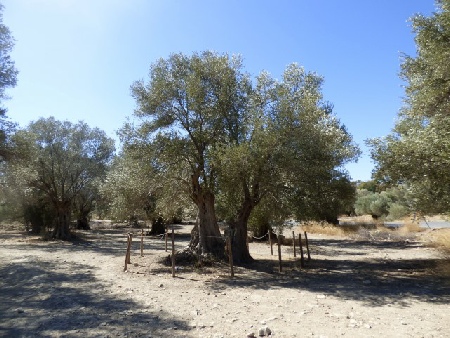

A ‘pile of old rocks’ at Gortyz
The so-called 1,600 year old olive tree
We drove on westwards through the Messara Plain. At the large town of Mires, Adrian went into a large Carrefour to get more drinking water – cheaper than other places - and found the shop strange and empty.
We stopped at the site of Festos, climbing to the entrance. The vast site was set out below. I didn't fancy walking round another place in the heat, even if the 'oldies' rate was only €4 instead of €8. The pleasant man at the desk said – 'you can look from the top, you only pay if you go down' So that's what we did. It looked good from here, especially framed by bougainvillea.
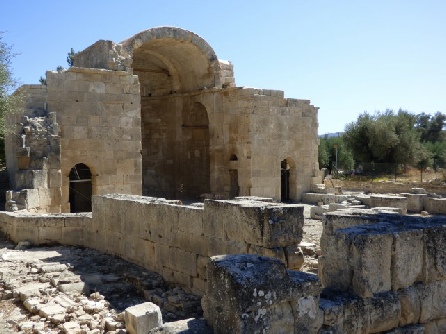

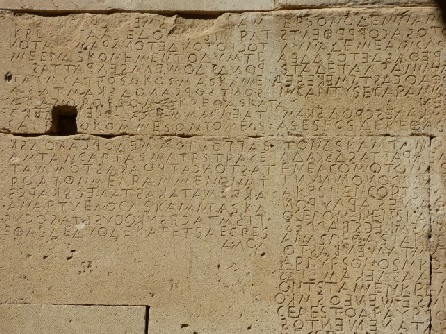

St Titus Church, Gortyz
The Odeion
Law code tablets
A more impressive olive tree
We'd seen enough old rocks for one day, so now made our way down towards the coast. We drove through pretty Siva, where we had trouble negotiating cars, coming down to Malata. This had been a real hippy hangout in the sixties, and still had a slightly hippy feel. We walked along a narrow street lined with shops and eating places, coming to the beautiful looking beach. This was really crowded, with lots of people enjoying the sea. We would liked to have joined them but had left our swim things in the car, so had to suffice with a paddle. The beach was actually of coarse grit, but the vertical barren sandy cliffs edging it made it look really attractive. The cliffs were famous for the caves formed in them, apparently hippy hangouts for such people as Cat Stevens, Joni Mitchell and Bob Dylan.
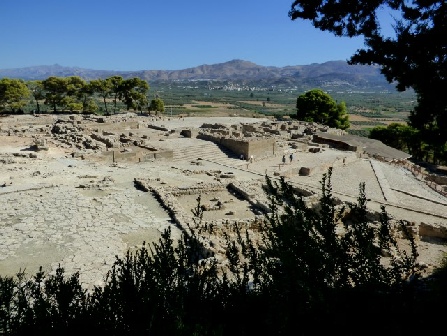

The site at Festos
We drove on to nearby Kommos, stopping first to enjoy the view beside a little chapel of this bit of coast, and looking across to Agia Galini. We drove on down to the beach, where there were some sunbeds, but far less people. We changed into our cozzies this time, but were thwarted, as in addition to having small waves, there was an underlying line of rocks, so no good for us to swim. I sat on the edge of the water.

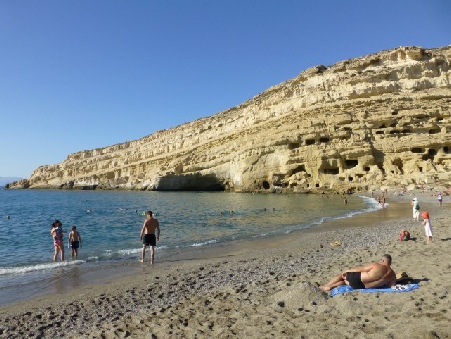
The beach at Malata with its caves
We drove back to Agia Galini via the steep and narrow village of Kamilari. It was 6 o'clock when we got back to Hotel Fevro – time when we'd got sorted for a drink on the balcony.
Tonight we had decided to eat at Faros, another restaurant recommended in Rough Guide. The fish was caught locally, and the restaurant run by a local family, but it didn't sell itself! Our waiter, who reminded us of Gareth, took us in to see the fresh fish, after we'd asked. We chose scaro (parrot fish) and pandora and we ordered a carafe of wine. There were no frills here – the food was good, and we were brought a little 'afters', but no raki tonight.
We walked back up, on the warm evening, to our hotel.
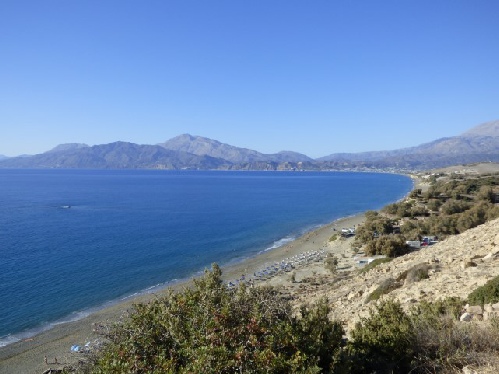
Looking to Agia Galini from Kommos
Saturday 15th October An ancient site, a museum, and a hotel with no-one there 85km
A lovely morning again. We ate our good breakfast on the balcony, served by the cheery lady. We were packed up and ready to leave at 9.45, but when we went to pay, the gruff proprietor said 'no card, cash only'. Hence Adrian had to go dashing off to get enough cash to pay. He also called at the bakers for some bread, but it only served cakes, and he had to trail the back streets to find a bread shop so it was gone 10.00 when we left. The smiling wife at the hotel had given us a bottle of family produced olive oil.
We followed yesterday's route back through Timbaki, across the Matala plains with all its plastic greenhouses.
We hadn't far to go today, so planned to stop at two of the places we hadn't had time for yesterday. The first was Agia Triada, near Festos, which we reached at 10.30. It was another 'pile of old rocks', but in a lovely location looking out to the Gulf of Matala and down to the plain. First we had to clamber down a long steep set of rough steps, to the glum man at reception. It only cost us €2 each (oldies rate) to get in. It was good being there early, as it was a pleasant temperature. It was a large site, and had contained many frescoes but these are now housed in Iraklio Archaeological museum. The little 13th century chapel of St George built on the site appealed to us. There were shady seats overlooking the site, and Adrian gallantly climbed up all the rough steps to get our flasks of tea and coffee.
We climbed back up the steps at 11.30, and set off for nearby Vori, where we'd read that there was an Ethnological Museum. We drove through the quaint, unpretentious, white village, which had no concessions to tourism, except a small tourist information, where we asked directions to the museum. We'd had to park in a rough area before wandering the narrow streets. We'd heard that the museum was tucked away in a side street, and it certainly was!
The museum (€3each) was rather old fashioned (circa 1992), but was crammed with artefacts, all behind glass screens. I was amused to see a log basket much like ours. Everything was labelled in English as well as Greek, but I found things difficult to read in the dim lighting. We had quite a chat to the lady receptionist afterwards. She sadly said what a struggle it was to keep the museum going, as the government wanted to close it. She also said that most craft skills had been lost, and people weren't yet interested enough to redevelop them. All rather sad.
We now followed yesterday's route back past Gortyz to Ayli Dreki. We'd toyed with the idea of eating lunch on the old bit of wall in Gortyz carpark, as we had yesterday. We should have done this, as lunchtime was not a success!
We turned south onto a minor road at Ayli Dkeki, driving through the miles of olive groves. After Vagionia we came to the village of Fournofarango, which we hadn't expected to be in. We spied a bit of shade beside a (dry) fountain, and stopped to have lunch, sitting on the narrow surrounding wall. Unfortunately the wind was blowing in sudden gusts, which was too much for me, so I ended up sitting in the car!
Continuing on our way, we came to the village of Charakas, which had a huge pillar of rock with a building on the top. The village also had an interesting bell tower.
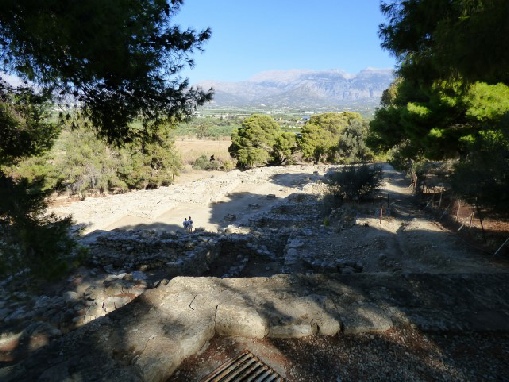
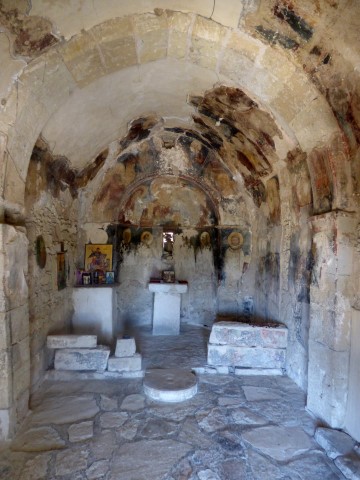
The ancient site at Agia Triada and 13th century chapel of St George
We now left the plains, and ascended the steep barren mountain range before descending dramatically to Tsoutsouras via dozens of hairpin bends. This was to be our stopping place for tonight. The seaside town was hidden from view until the last moment. We first saw the deserted harbour before driving along the desolate front.
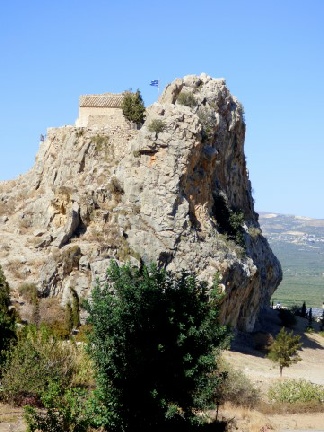
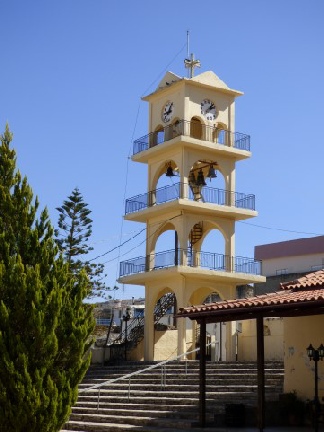
Huge rock at Charakas
Interesting bell tower
The place must be teeming with visitors in summer, but there was hardly any sign of life today. We came to Triton Hotel which we'd booked, and went in. Not a soul! We waited around for quite a while - Adrian even phoned and got no reply - so as we were right beside the beach, we thought that we'd go for a swim. The beach was of grey grit/sand, and the blustery wind was blowing here too, but the water was warm. While I dried off on the beach, Adrian tried the hotel again and this time he found an elderly lady - the owner's grandmother. She spoke no English, but it seems that the hotel is closed, or about to close for the season, and the owner is away. The good news was that we had a pleasant room overlooking the beach, so once we'd sorted all our stuff we sat on our balcony with a cup of tea and later with an aperitif.
We ate at Zorba's, next door, recommended in Rough Guide. There was a French couple there when we arrived, and later a local couple came in, but that was all. We enjoyed calamari/dorado with some house wine. We chatted to our genial host, who came from a local village. The watermelon which came with our saki was delicious. We were given another bottle of local olive oil.

The harbour at Tsoutsoura
Sunday 16th October East to Ierapetra 66km
Another hot and sunny day, a bit windy at first, making ripples on the sea – so no swim here before we left!
We had to walk along to a nearby taverna for breakfast. There were a total of 5 guests, but this was plenty for the old couple serving us – the grandma from the hotel and her poor henpecked husband. We heard constant nagging from the kitchen – she sounded like an Italian wife. The dear old chappy staggered in with each tray of food – things didn't happen quickly!
He seemed to understand no English at all – not even tea and coffee. We were served a fried egg with tomato and interesting olives, plus the usual bread/jam etc plus one bowl and spoon of yogurt with honey. Still, the hotel was cheap!
It was after 10.00 when we got going, driving along the coast eastwards to Kastri where we were ascending into the mountains.
We continued past our turnoff, beside nice unspoilt beaches, but they were all pebbly, so no swim. We enjoyed tea/coffee in the shade of a tree on the beach, it was really peaceful. Then it was the spectacular climb up into the mountains with constant hairpins. It was so quiet when we stopped to look down.

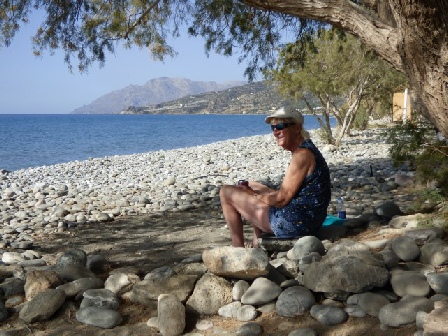
The beach at Tsoutsoura
Shady coffee stop near Kastri
We drove through the once very important mountain village of Ano Viannos which now has an EU bypass around it. We ate lunch sitting on a wooden seat beside the road, under a shady tree near Pefkes before descending to the sea again at Myrtos. This town looked very photogenic perched above the beach when we looked back to it. We could see people enjoying the sea, and hoped to join them. We descended the steps to the pebbly/shingly beach. Here we did have a pleasant swim even if it shelved steeply. While we were on the beach afterwards, a man came from the end restaurant with a huge fish which he washed in the sea before cutting up.
After this, we drove through an unpretty area of plastic greenhouses. Even the towns were drab here.
We reached Ierapetra, our stopping place for tonight, and apparently the most southerly town in Europe. It didn't appear very pretty as we drove through. We reached our hotel, El Greco, and were luckily able to park right outside.
It was a rather smart hotel, with fairly spacious accommodation. Our balcony overlooks the street, with just a glimpse of the beach – there's a better view from the bathroom (with yes, a bath again!)
Adrian was really pleased that there was a lift to our third floor room, after the last few nights of so many steps to carry the bags up!
After settling in, we walked along the front to the Venetian Fortress, known as Kales, beside the old harbour.
There were eating places all the way. We wandered back through the little streets of the old town. This was another world of white painted houses, many with pots of plants outside, and with elderly men and women sitting watching the world. The few children were just as European looking as any kids! We passed the house where Napoleon is reputed to have stayed in 1798.
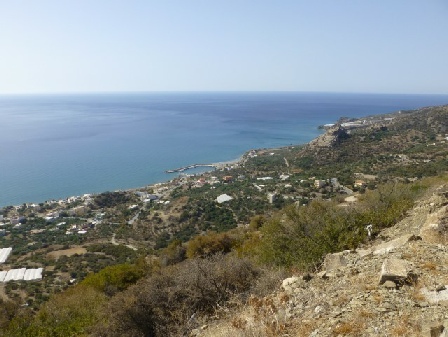

Looking down towards Kastri
Myrtos, where we did have a swim
We had looked at various places to eat tonight and had decided on the one furthest away! We walked past all the other eating/drinking places, arriving at Levante, opposite the Fortress. After courgette/eggplant starter, we enjoyed sardines (A) and 'shrimps' – huge prawns,( me) with a glass of beer. Raki tonight came with some very sweet grapes. When we went to pay, we had an interesting, and rather depressing conversation with the owner about Greece and the European situation. He said everybody in Greece was living day to day with no thought for the future as they will be paying off their country's 'debt' for the next 50 years.
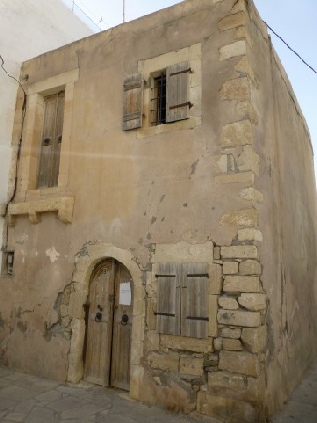

St Georges Church, Ierapetra and ‘Napoleon’s house’
Monday 17th October Fun stops on our way to Sitia 61km
We enjoyed a well laid out buffet, overlooking the sea. The only bad thing was no butter, only margarine!
When Adrian took the bags to the car, he was surprised to be greeted by the owner from last night's restaurant! He was going to the tax office opposite our hotel.
At 9.30 we checked out with the delightful lady receptionist and by 9.45 we were setting off eastwards past the empty long beach. Near Ferma we scrambled over jagged rocks to view the Roman fish tank set into the rock.
We stopped at a little supermarket, and bought a loaf. We were hoping also to buy butter, but the rather sad owner said that he hadn't any, he was closing down soon, hence the empty shelves. We didn't know if he meant for the season or for good.
On a hazardous hairpin at Agia Fotia, we took a rough track down to a shingle cove with a taverna and sunbeds and some shaggy palapas. We had coffee here, but not the swim we'd hoped for as it was steep and pebbly. Soon afterwards at Achlia there was another pleasant cove with taverna and sunbeds, but again we didn't swim.
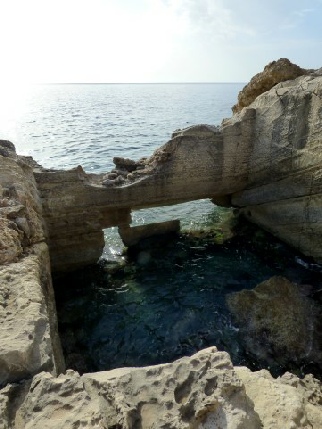
Roman fish tank at Ferma
Just before Koutsana we stopped by 'Butterfly gorge' and walked on a rough track through fir trees, but not as far as the gorge. On our return, three white geese menaced us!
At a small supermarket we were able to get the butter and cheese that we wanted. Adrian went back to get some more tonic!
Then at Moni Kapsa – with a monastery set high up at the end of Pervolakia gorge – we ate our lunch, precariously balanced on rocks under tamarisk trees. Here we did see a painted lady butterfly! No swim again, as the beach was rocky. However, we were surprised and delighted to find that we could walk a short way up the gorge, with its incredibly high vertical bare rock sides towering above us.

The shingle beach at Agia Fotia
We didn't go up to the monastery as it was closed, but it is apparently a place of pilgrimage. We continued driving along the wild rocky rugged coast as far as Goudouras, which unfortunately had lots of plastic greenhouses.
Just before here though, we came to a delightful isolated, rocky cove of bare rocks, pebbles, and just a bit of sand. Here we did have our swim, and it was delightful! There was even a water pipe, with warm water to wash our feet afterwards!

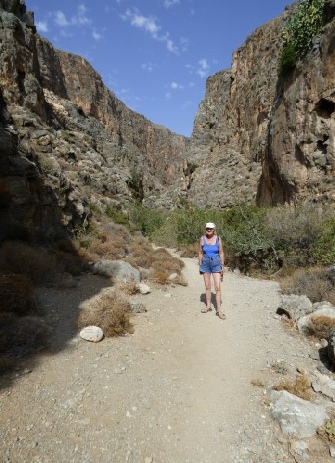
Pervolakia gorge and Moni Kapsa
Now we turned inland, with olive trees dotting the arid, bare rugged slopes. There were a few vines haphazardly growing beside the road too.
At Ziros, we followed a rough track to Voila, a ruined mediaeval village. We had a lovely wander around this site, in our isolation, with the incongruous sight of wind turbines on the hill behind!
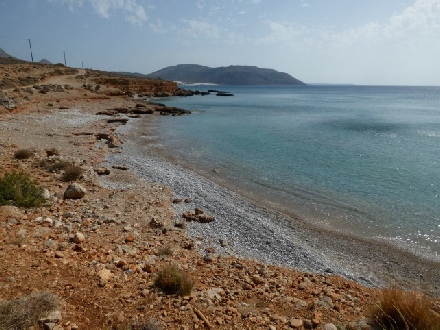

Delightful cove where we swam near Goudouras
Nearby Etia was a fascinating place too – a Venetian mansion (EEC restored, and not open), but the interesting part was the walls of the houses of the former village, an evocative sight!

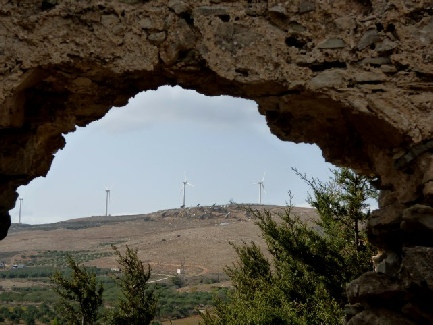
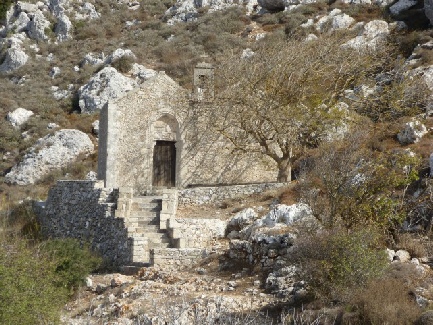
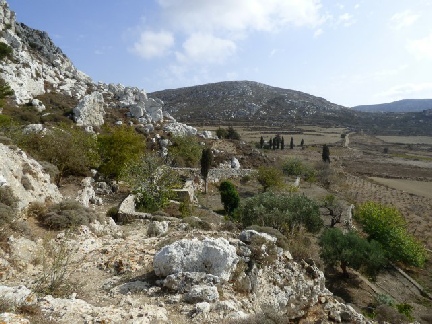
The evocative medieval village of Voila
Now we made our way to Sitia, and our Hotel Elysee . The entrance from the car park was not salubrious, entering from the rear door past the toilet! The lady receptionist welcomed us in broken English. We took the small lift up to our 4th floor apartment (the only one on this floor).
We were pleasantly surprised to find a large room (for 4), with kitchenette and a huge balcony overlooking the harbour.
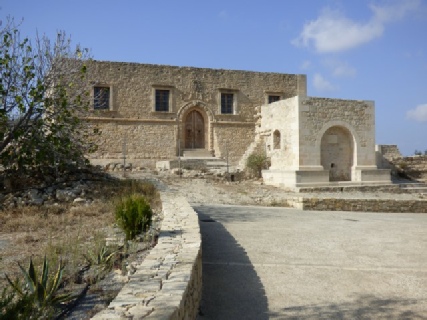


The abandoned Venetian village and restored mansion at Etia
Later we walked along beside the harbour, stopping at Zorba's (another one). We were served by an older waitress with our veggie meals of stuffed vine leaves and stuffed tomato and pepper. She'd told us that there was fish. When Adrian asked what kind, she'd said 'fresh'! We were served melon afterwards, but no raki tonight!
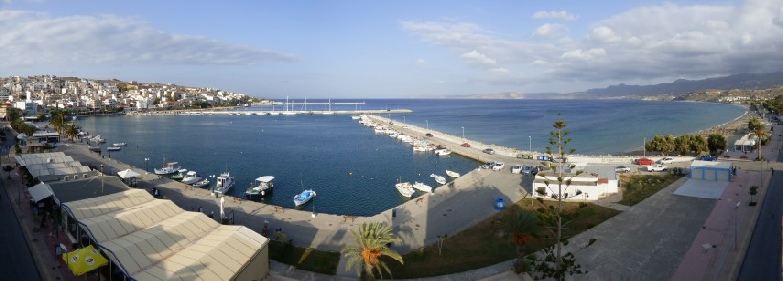
View from our balcony, Hotel Elysee, Sitia

The view at night
Tuesday 18th October The far north east of Crete 61km
The wind had howled in the night, especially as we were four floors up. The day that followed was windy, but became hot in the sun. There was a dramatic sky as the sun came up above the mountains by the sea.
We went down to breakfast, and came into the empty dining room, and were about to go back, as we thought that we must be early. The receptionist said 'sit down', and soon started to serve us. It was just us for breakfast - maybe nobody else is staying here.
The bread was very fresh. We had sufficient food, but there were no 'extras' – the hot food containers stayed empty.
We left at 9.50 to see something of the far east of Crete. Adrian was wearing jeans for the first time during the day, and I was in leggings, but we soon changed into shorts.
We drove through the town of Piscokefalo, taking a tortuous route through the tiny narrow streets, where we saw oranges and pomegranates growing, to our road through the hills.
We started to ascend the mountains, driving through Zou where there was a spring. High up on the mountain top there was a crowd of wind turbines, and also solar panels looking like perched roofs. Olive trees were growing on any flatter bit of land.
We followed a very deep and steep valley, coming to Katsitoui, perched high up. Much of the rock was a plum colour, contrasting with the usual white and beige. We stopped for coffee in this barren wilderness, sitting in the car as the wind howled outside. While we were there, the skies cleared, and we had blue sky for the rest of the day. We could see a patchwork of fields lower down, and now we started our descent on a continual serpentine of bends. We stopped to view the Gorge of the Dead and then had staggering views down to Kato Zakros with the blue sea with 'white horses', dramatic brown mountains cut by gorges right down to the sea, and green trees.

Glorious morning sky at Sitia
We stopped by the sandy/pebbly beach, which was deserted of course. It looked inviting, but not for swimming today! There were a few simple tavernas, set up with tablecloths, despite the wind. A lady was sweeping up in one. We continued to the Palace of Zakros, an ancient Minoan site, which we viewed through the fence. It was humbling to think of people living here 3,600 years ago.
Back at the beach, we spied a little blue painted shelter, with a bench inside. There was an exhibition of photos by a local man who had died last year, and had obviously been greatly loved. It made a wonderful place for us to eat our lunch, looking out to the pale blue sky, the deep aquamarine sea with its white foam and the beige coloured tamarisks and beach – beautiful!
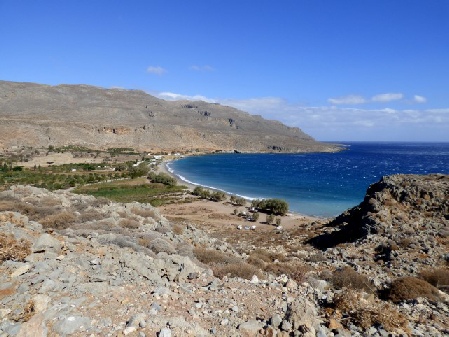
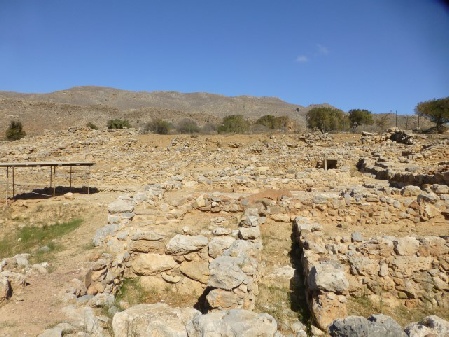
Kato Zakros
The Minoan palace of Zakros
We left here at 1 o'clock, driving back to Zakros through a swathe of green olive trees laden with fruit. We stopped and I filled my water bottle from one of the springs. We continued north through Palokastro to Kouremenos beach, famed as a place for windsurfers, but there were none today! Why? It certainly wasn't lack of wind! It was a delightful place with deep turquoise sea and a simple taverna. We drove on to the little harbour.

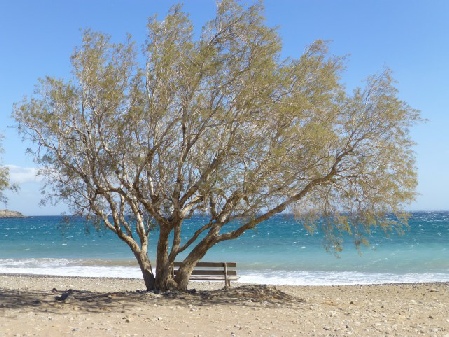
The beautiful deserted beach at Kato Zakros
North of here, we came to Vai - a beach where all the tour buses apparently come. It is backed by a group of date palms, a variety indigenous to Crete, and only found here. There were lots of cars parked, even today, but we didn't intend paying to join the crowds, even if the beach is supposed to be wonderful. Instead we drove a few miles to Itanos, which we thought idyllic - a little sandy cove, the sea in shades of blue and an ancient Minoan site on the hill above. I had a paddle in a pool made by the violent waves.
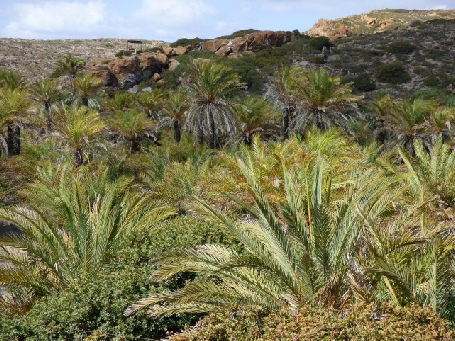
The date palms at Vai
We drove part way up the Sideros Peninsula - a finger of barren rock with deep blue sea either side. The government had hoped to develop a resort here, but luckily it seems not to have happened. The top part of the peninsula is military land, so we now returned past Vai to follow the rugged north coast back to Sitia. Adrian had been surprised to see melons growing in patches beside the road.

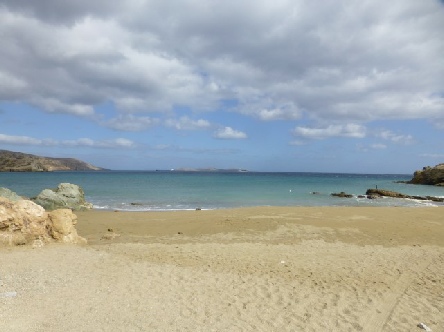
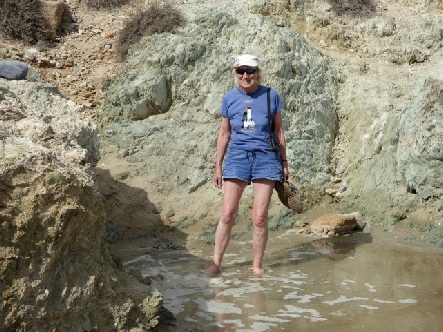
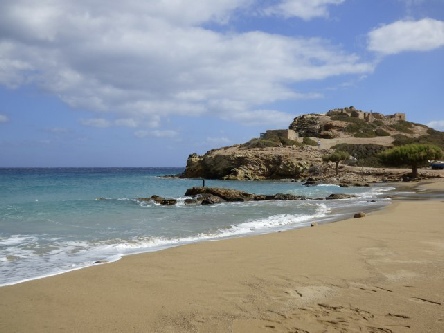
Idyllic Itanos
We passed Moni Toplou, with a pretty windmill next to it and reached Sitia at 3.30. We followed a tortuous route up to the Venetian fortress, closed now, but affording good views down over Sitia. The drive back down was similarly nightmarish, through the narrow streets, as we found our way to the Roman fish tanks set into the now promenade. It was difficult to make out what we were looking at - nothing had been made of them. We guessed that we were in the right place, as ducks and geese were nesting on them, as the book said!
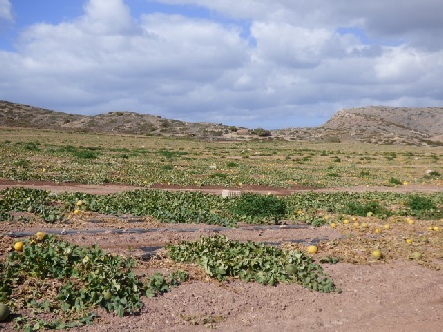
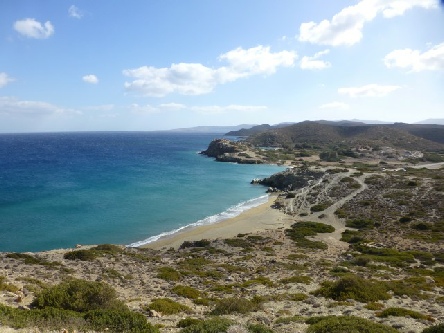
Looking back to Itanos
Watermelons growing - a rare sight
We got back to our room at 4.30, to discover that ants had made an unwelcome visit - on the 4th floor!
It was cool and windy when we walked out to eat tonight. We didn't find the restaurant that we were looking for, so ate at Inodion beside the harbour. It was a popular and busy place, which meant that we waited a while to be served. The two waiters looked alike, making us think of Gareth & Matthew, not knowing which was which. We ate mussels and prawns, which were not as easy to peel as last night's. They came with no extras, so we ordered fried potatoes. Raki came tonight with grapes and watermelon.
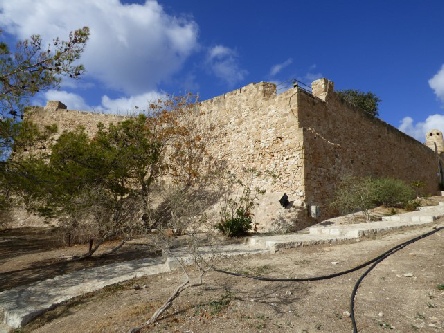
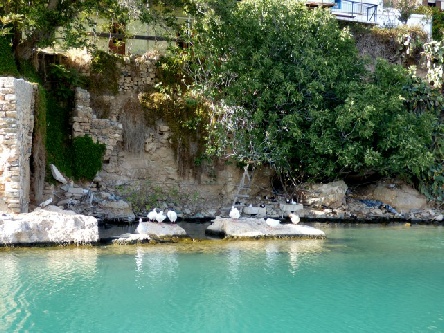
Sitia’s Venetian Fortress
Ducks take over the Roman fish tanks
Wednesday 19th October To Agia Nicholaos and a former leper island 79km
It was a nice sky again, with the sun peeping from behind the clouds. There were 3 other people at breakfast this morning - we spoke to an Austrian tourist, who said that it was usually warmer here at this time of year.
We paid the efficient receptionist and by 9.30 we were on our way towards Agia Nicholaos, stopping to get fuel.
The countryside was green with olive trees. We drove on a short stretch of new empty motorway - the rest was being built, carving through the rugged, wild mountain scenery.
We stopped by the pretty, steep mountain village of Exo Mouliana to view the Richlis Gorge which apparently has water running through it all year.
A bit further on we looked at the spectacular view from Morsini, and then again at Platanos. From here there were views to Agio Nicholaos and to the island of Psira. We had our tea/coffee, while constant tourists stopped to view and photograph.
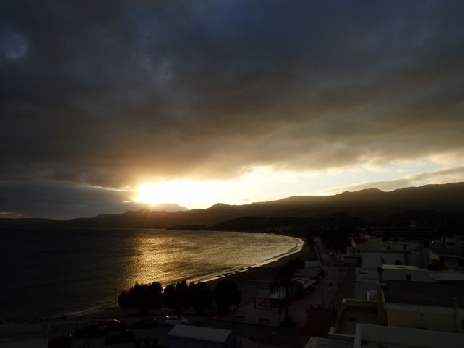
Another lovely sky at Sitia
The valley below was a sea of olive trees as we drove along, stopping at the sandy/pebbly beach of Pachia Ammos, where a few little allotments occupied land beside the sea. It was warm but windy, and a lot of rubbish had been washed up from the sea.
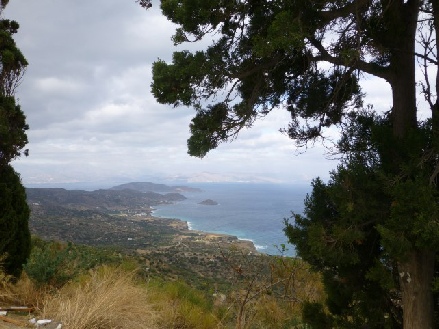

View of the north coast from Morsini
And from Platanos
Just afterwards, we pulled across to a viewpoint marked on the map, and found that we had a glorious view to the former town of Gournia - dating from 3,500 years ago! We could see the town laid out as if it was a plan, with all the walls visible.
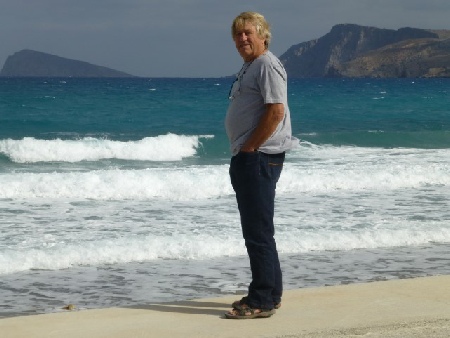
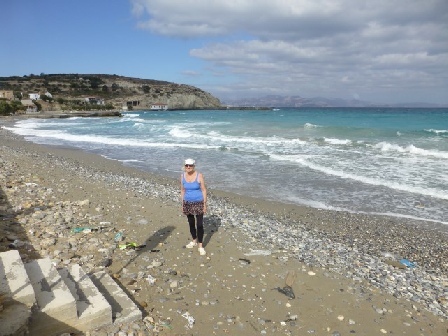
The beach at Pachia Ammos
Like yesterday, the skies had now cleared, and the rest of the day was sunny. The sea looked incredibly blue as we looked down to the Gulf of Mirabello, with increasing tourist development as we neared Agio Nicholaos.
This is where we are staying tonight. We drove through the busy streets, parking by the front to walk to Lake Voulismoni. With its steep sides, it made us think of the blue pool in Mt Gambier, Oz. The water was deep and really clear - we could see fish swimming and one man was also out swimming. Eating places surrounded the pool, and it was milling with people.


The Minoan town of Gournia
The sea looked incredibly blue as we continued to Hotel Lato, north of the town. It was a very smart place, festooned with bougainvillea. Although only midday, we were able to book in. We were given the choice of two rooms, and chose the lower one, looking over the pool, and through palm trees to the sea.
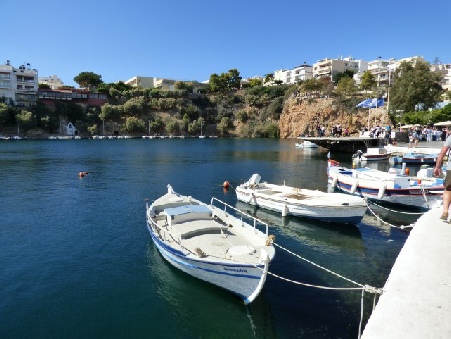
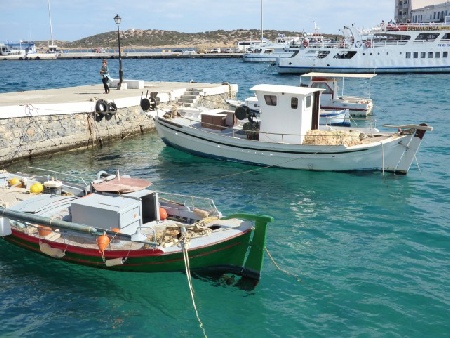
Agio Nicholaos
With its Lake Voulismoni
Having brought in some of our bags, we ate lunch sitting on our balcony. We followed this with a swim in the pool, and 5 minutes laze in the sun.
At 2.20, we were on our way again, driving northwards past the big and busy tourist town of Elounda, opposite Spinalonga peninsula. We drove as far as Plaka, with the intention of visiting Spinalonga island. This island - a fortress since Venetian times - had been used as a place for a leper colony last century. It was only closed in 1957. I wasn't sure that I wanted to visit - I felt rather like I had when visiting Robben Island, and didn't know if I'd cope. However, I had started reading a book which Hilary had lent me by Victoria Hislop, which was centred on this island, so we decided to try. A boat was unloading as we arrived, so there we were, after a short wait on board, sailing across on the short journey to the island. It was really windy on the boat. At 3.15, we alighted and joined the crowds of other visitors. I didn't like the idea of it becoming a tourist attraction, which it certainly is. We were surprised that we had to pay to visit the island, but pleased that 'oldies rate' was only €4 each. We made our way right around the island. There was a lot of information on both the leper colony, and its former occupancy, but I couldn't help thinking of all the people stranded here, unable to leave. It had a feeling like Alcatraz.
All told, I was pleased to have fitted a visit into our busy schedule.


View from our balcony, Hotel Lato, Agio Nicholaos
Back at the dock we didn't know how you knew which boat to take back - some went to other destinations, and there were no signs! A small boat arrived, and we boarded - no tickets or questions - and luckily it was the right boat - but a different one from the outgoing one! Back at Plaka - a small village which was once the supply centre to the island - we had a short look at the few eating places and gift shops, then drove back south. We managed to find the causeway onto Spinalonga peninsula, which had some attractive derelict windmills but nothing else. Apparently it is packed in summer.
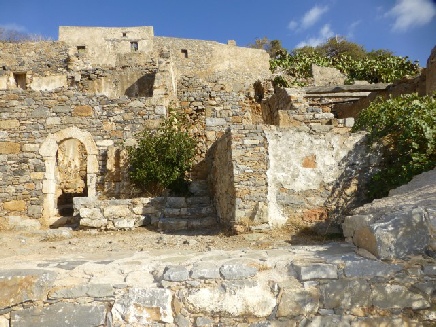



Spinalonga Island
We arrived back with just a bit of sun on our balcony, where we sat with our cup of tea.
We ate tonight at a little taverna, Kri Kri, just along the road. We chose a selection of Cretan dishes, which was good, but plenty! The carafe of house wine went well with it!
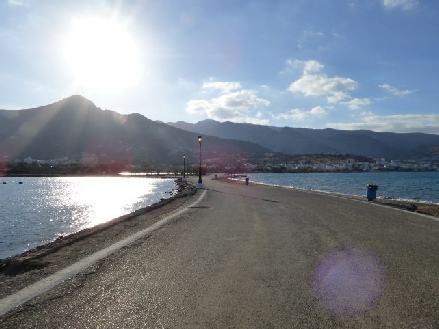
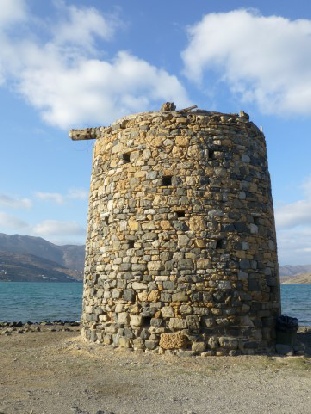
The causeway to Spinalonga peninsula and one of the derelict windmills
Thursday 20th October The Lasithi Plateau on our last day 92km
The breakfast this morning was good – with 3 choices of marmalade, whereas usually there is none, so Adrian was happy! We sat outside – the place was quite busy.
We left this hotel, where the staff were very pleasant, at 9.45 for our last day on Crete. We had really loved our time here, but don't think that we would in high season.
It was only a few miles to tonight's stopping place at Malia, so we were taking a route up into the mountains to the Lasithi Plateau.
We were very soon ascending into the barren mountains, sprinkled with olive trees – very thickly in the valley bottom, but sparsely on the slopes. There was no sign of human existence until we came to the village of Ano Amigdala. We passed a lovely old windmill, and then in this remote wilderness, we came to a new stone seat, which made an unexpected and delightful coffee stop. It was warm, and oh so peaceful, with just the sound of goat bells. A butterfly hovered by, and above us was a small church. In the distance was the village of Exo Potami.
Soon after this we drove through Mesa Potami where elderly ladies were beckoning to us to buy their honey.
We reached the Lasithi Plateau at Agya Konstantino There was a circuit that you could drive, and which obviously was on the tourist route, but today was pretty quiet. We drove to the village of Tzermiado which had a lot of shops selling embroidery. It reputedly also had a good bakers. We drove round it twice, and all we saw was a tiny cafe, with bread rolls on the counter. We bought two rolls (at €1 each) with none of the fillings!
It was cloudy and quite cool at this elevation as we continued on our circuit. We saw a great many of the old wind pumps that the area is renowned for – many re-sailed.
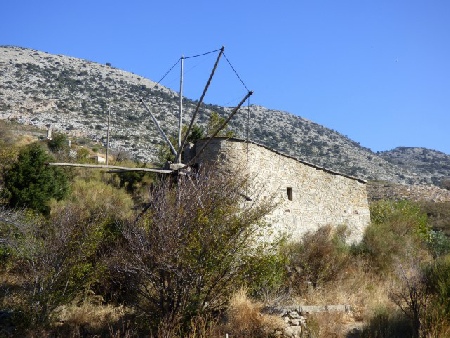

An ancient windmill and a little white chapel as we approach the Lasithi Plateau
We stopped to have lunch at Agios Charalandes, sitting on a concrete wall beside a trough of flowers. Nearby was a laden donkey – like Greece of old, and something we hadn't seen this time.
A group of Germans arrived at the same time, in a van and with a quad bike – the thing to do round here. There was a delightful old windmill, and in a taverna, men were cooking on a barbecue.
In the timeless villages were elderly women in black, and men sitting on seats outside bars.
By 1 o'clock we had completed the circuit. At the summit, there was a line of ruined windmills. This photogenic spot was also a coach stop.
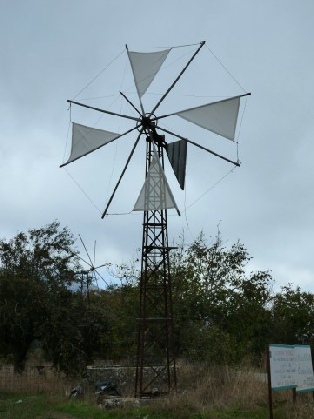
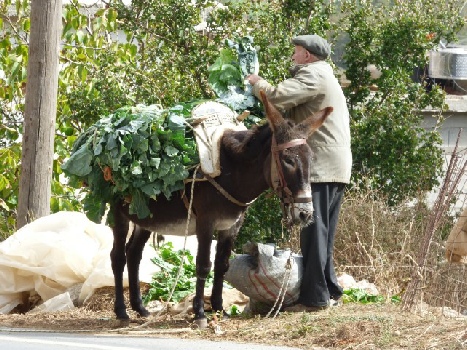
Windpump and laden donkey, Agios Charalandes
We now came into Heraklion Province as we began our descent to Malia on a continual hairpin through the steep, rugged, barren mountains. Imagine our surprise then, to come upon a Petit Train 1700ft up! (we saw half day trips advertised later.)
Malia, despite its pleasant sounding name, struck us as 'tourist grot', and we wondered what we had come to for our last night! We finally found our apartment 'La Playa - Hotel Beach' it was called, down a maze of tracks by the sea.
The proprietor welcomed us, but said 'one night' as if to say 'only'. He took us to our room, which was fine, with a view over the pool and the beach.
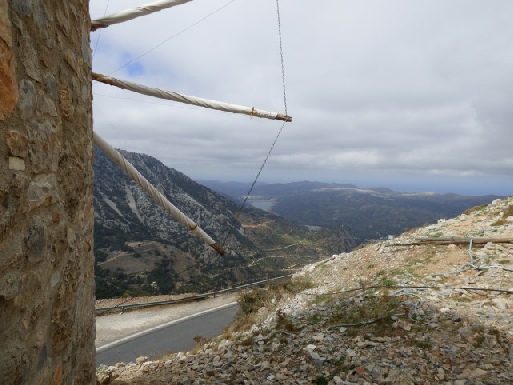
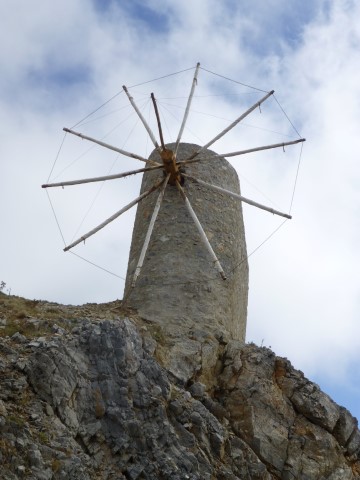
More ancient windmills as we begin our descent from the Lasithi Plateau
Being our last night, we needed to organise everything for 'flight mode', but first we enjoyed a cup of tea on our sunny balcony.
We followed this with a swim in the large, pleasant but rather cool pool, and five minutes on a sunbed. We walked onto the fine sandy beach, where several people were enjoying the rough waves, as we would have done once! We even had a couple of minutes on the sunbeds here too!
Having facilities in our apartment, we had thought that tonight we might eat in. We drove back to the road where there were one or two so-called supermarkets, but these were either closed for the winter or tourist gift shops with a few non-perishable goods at the back! We gave up the idea of cooking, but still wanted something for breakfast and lunch tomorrow. In one store we did buy some cheese and muesli bars. Restaurants were just as difficult - most were shut up for the winter – we found just two open! The soil here was rich and red.
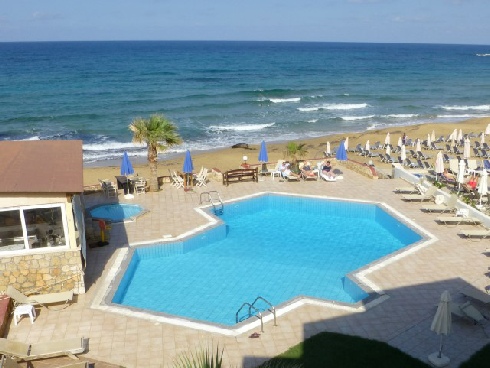
View from our balcony, Hotel Beach
Later we walked back up to the road – trying a diversion through the grounds of another complex, which didn't work! We located the restaurant called Paradise, where we enjoyed an excellent last meal. They didn't have the fish soup which I'd fancied, but the swordfish and sea bream were good. There were several other diners. We had a half carafe of house wine, and were served a crepe and icecream with our raki afterwards. A nice last supper!
It was absolutely silent as we walked back – not a soul about – just the chirping of the cicadas.

The rich red soil at Malia
Friday 21st October Going home! 32km
It was partly cloudy as we ate our simple breakfast sitting on the balcony. We drove back to the little supermarket where we bought some rolls for lunch, and olive spread to go with the cheese.
Back at 'Hotel Beach', we walked down to the sandy but rather scruffy beach, enjoying the sun which had now come out.
We had tea/coffee on the balcony before leaving at 10.45 to drive to Heraklion Airport. We took the motorway, as there is almost constant tourist development beside the sea, backed by fields of olive trees.
We had no problem in returning the car, which had served us well, if a little lacking in 'go'.
It was the usual unpleasant experience in the airport. There was no 'self bag drop' here – after queuing to have the bags weighed and checked, everyone had to make way past the queues to put the bags on the belt to go through the security scanner. Going past passport control and security was all OK, especially as you could leave everything in the bag, including computers.
At our gate, we ate the rolls we had made. Sitting near us were a family (Dutch/US or Canadian) with three delightful young blond boys, aged about 1, 4 and 6. They were so well behaved and happy, despite the older one (who must have been diabetic, as his father injected him), bumping his head on the seat. They were heart-warming to see.
We were called to load, and as on the outward journey, then had to wait ages on the stairs – in this case it seemed as though they were hurrying to clean the plane after it had arrived. At least we could look at the coast and sea, in the sunshine.
We had a good flight, and were very pleased to start work on the website, which our busy schedule had prevented us from doing before.
We arrived at Gatwick on time (3.45), and apart from the horrendously long walks at South Terminal, all went well. We collected our bags, and then things went wrong. Being our first time at this terminal, we couldn't find our way to our 'meet and greet' place. We walked this way and that, but by now I found it was all too much! When we finally got to our man, he pleasantly said 'well, you're here now, that's all that matters, but I must go, I've got to catch the bus'.
We drove out into English countryside, enjoying the autumn colours. Hearing that there was a problem on the M25 (Friday evening of half term) we drove cross country through Reigate and Dorking. We were really enjoying it, eating the sandwiches we'd hurriedly bought in M&S at the airport, until we got to Guildford, that is. The traffic hold-ups here were appalling and it was really slow going.
We reached home at 8 o'clock, listening to the penultimate programme presented by dear Desmond Carrington – now giving up, in his nineties!
We'd really enjoyed our time in Crete in almost perfect weather.
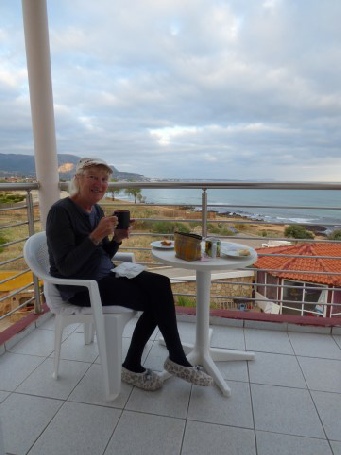

Farewell Crete!
Some things we liked about Crete
The lovely temperature
The almost constant sunshine
The nice food
The many empty, unspoilt beaches
The easy people, despite us knowing no Greek
The dramatic scenery with spectacular mountains
The lack of traffic, outside towns
The warm sea
Few tourists out of season
Timeless white villages
Brilliant bougainvillea
Complimentary raki and dessert/fruit at the restaurants
Days away - 18 : Distance travelled - 1300km (830 miles) - Average 72km (46 miles) per day
Crete October 2016
Note in this diary, the spelling of place names are variable, as I and Y, Ch and H, H and I are all a bit interchangeable









